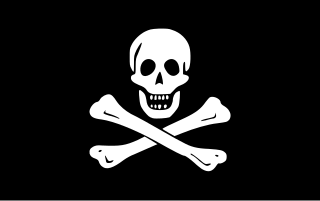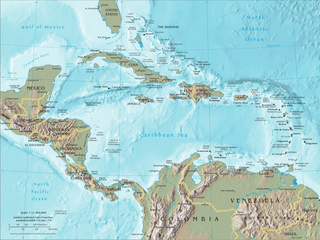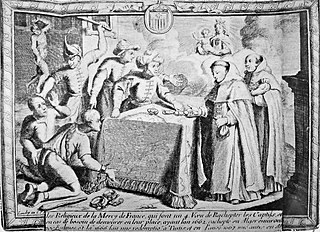Related Research Articles

Piracy is an act of robbery or criminal violence by ship or boat-borne attackers upon another ship or a coastal area, typically with the goal of stealing cargo and other valuable items or properties. Those who engage in acts of piracy are called pirates. The earliest documented instances of piracy were in the 14th century BC, when the Sea Peoples, a group of ocean raiders, attacked the ships of the Aegean and Mediterranean civilizations. Narrow channels which funnel shipping into predictable routes have long created opportunities for piracy, as well as for privateering and commerce raiding. Historic examples include the waters of Gibraltar, the Strait of Malacca, Madagascar, the Gulf of Aden, and the English Channel, whose geographic structures facilitated pirate attacks. A land-based parallel is the ambushing of travelers by bandits and brigands in highways and mountain passes. Privateering uses similar methods to piracy, but the captain acts under orders of the state authorizing the capture of merchant ships belonging to an enemy nation, making it a legitimate form of war-like activity by non-state actors.

Buccaneers were a kind of privateers or free sailors peculiar to the Caribbean Sea during the 17th and 18th centuries.

A privateer is a private person or ship that engages in maritime warfare under a commission of war. Since robbery under arms was a common aspect of seaborne trade, until the early 19th century all merchant ships carried arms. A sovereign or delegated authority issued commissions, also referred to as a letter of marque, during wartime. The commission empowered the holder to carry on all forms of hostility permissible at sea by the usages of war. This included attacking foreign vessels and taking them as prizes, and taking prize crews as prisoners for exchange. Captured ships were subject to condemnation and sale under prize law, with the proceeds divided by percentage between the privateer's sponsors, shipowners, captains and crew. A percentage share usually went to the issuer of the commission.

A letter of marque and reprisal was a government license in the Age of Sail that authorized a private person, known as a privateer or corsair, to attack and capture vessels of a nation at war with the issuer. Once captured, the privateer could then bring the case of that prize before their own admiralty court for condemnation and transfer of ownership to the privateer. A letter of marque and reprisal would include permission to cross an international border to conduct a reprisal and was authorized by an issuing jurisdiction to conduct reprisal operations outside its borders.

The era of piracy in the Caribbean began in the 1500s and phased out in the 1830s after the navies of the nations of Western Europe and North America with colonies in the Caribbean began combating pirates. The period during which pirates were most successful was from the 1660s to 1730s. Piracy flourished in the Caribbean because of the existence of pirate seaports such as Port Royal in Jamaica, Tortuga in Haiti, and Nassau in the Bahamas. Piracy in the Caribbean was part of a larger historical phenomenon of piracy, as it existed close to major trade and exploration routes in nearly all the five oceans.

Jolly Roger is the traditional English name for the flags flown to identify a pirate ship about to attack, during the early 18th century.

Corsairs were privateers, authorized to conduct raids on shipping of a nation at war with France, on behalf of the French crown. Seized vessels and cargo were sold at auction, with the corsair captain entitled to a portion of the proceeds. Although not French Navy personnel, corsairs were considered legitimate combatants in France, provided the commanding officer of the vessel was in possession of a valid letter of marque, and the officers and crew conducted themselves according to contemporary admiralty law. By acting on behalf of the French Crown, if captured by the enemy, they could in principle claim treatment as prisoners of war, instead of being considered pirates. Because corsairs gained a swashbuckling reputation, the word "corsair" is also used generically as a more romantic or flamboyant way of referring to privateers, or even to pirates. The Barbary pirates of North Africa as well as the Ottoman Empire were sometimes called "Turkish corsairs".

The Barbary pirates, sometimes called Barbary corsairs or Ottoman corsairs, were Ottoman and Berber pirates and privateers who operated from North Africa, based primarily in the ports of Salé, Rabat, Algiers, Tunis, and Tripoli. This area was known in Europe as the Barbary Coast, a term derived from the name of its ethnically Berber inhabitants. Their predation extended throughout the Mediterranean, south along West Africa's Atlantic seaboard and into the North Atlantic as far north as Iceland, but they primarily operated in the western Mediterranean. In addition to seizing merchant ships, they engaged in Razzias, raids on European coastal towns and villages, mainly in Italy, France, Spain, and Portugal, but also in the British Isles, the Netherlands, and as far away as Iceland. The main purpose of their attacks was slaves for the Ottoman slave trade as well as the general Arab slavery market in North Africa and the Middle East. Slaves in Barbary could be black, brown or white, Catholic, Protestant, Orthodox, Jewish or Muslim.
Pirate havens are ports or harbors that are a safe place for pirates to repair their vessels, resupply, recruit, spend their plunder, avoid capture, and/or lie in wait for merchant ships to pass by. The areas have governments that are unable or unwilling to enforce maritime laws. This creates favorable conditions for piracy.
John Ward or Birdy, also known as Jack Ward or later as Yusuf Raïs, was an English pirate around the turn of the 17th century who later became a Barbary Corsair operating out of Tunis during the early 17th century.

The Golden Age of Piracy is a common designation for the period between the 1650s and the 1730s, when maritime piracy was a significant factor in the histories of the Caribbean, the United Kingdom, Indian Ocean states, North America, and West Africa.
Nicholas Brown was an English pirate who was active off the coast of Jamaica during the early 18th century.
David John Starkey is a specialist in eighteenth- and nineteenth-century British maritime history. His research focuses on shipping, seafaring, privateering, fisheries and marine environmental history.
Jan Janszoon van Haarlem, commonly known as Murat Reis the Younger, was a Dutch fighter in the Ottoman Navy who reverted to Islam after being captured by a Moorish state in 1618. He began serving as a Navy fighter, one of the most famous of the 17th-century "Salé Rovers". Together with other corsairs, he helped establish the independent Republic of Salé at the city of that name, serving as the first President and Grand Admiral. He also served as Governor of Oualidia.
Claes Gerritszoon Compaen, also called Claas Compaan or Klaas Kompaan, was a 17th-century Dutch corsair and merchant. Dissatisfied as a privateer for the Dutch Republic, he turned to piracy and captured hundreds of ships operating in Europe, the Mediterranean and West Africa during the 1620s.

Anglo-Turkish piracy or the Anglo-Barbary piracy refers to the collaboration between Barbary pirates and English pirates against Catholic shipping during the 17th century.
Piracy in the ancient Mediterranean has a long documented history, from the Late Bronze Age. According to the classical historian Janice Gabbert "The eastern Mediterranean has been plagued by piracy since the first dawn of history." Though its prehistory is ambiguously differentiated from trade, this period in history marked the earliest documented wave of piracy.

Piracy in the Sulu Sea historically occurred in the vicinity of Mindanao, where frequent acts of piracy were committed against the Spanish. Because of the continual wars between Spain and the Moro people, the areas in and around the Sulu Sea became a haven for piracy which was not suppressed until the beginning of the 20th century. The pirates of that period should not be confused with the naval forces or privateers of the various Moro tribes. However, many of the pirates operated under government sanction during time of war. Following the end of World War II, piracy in the Sulu Sea reemerged as a phenomenon that persists to this day.

During the late 18th and early 19th centuries, many French privateers and letters of marque bore the name Duguay-Trouin, named for René Duguay-Trouin: René Trouin, Sieur du Gué, French privateer, admiral and Commander in the Order of Saint Louis. Between 1760 and 1810, warships of the Royal Navy captured seven different French privateers all with the name Duguay-Trouin.
References
- ↑ Jowitt, C., (2003) 'Parrots and pieces of eight': recent trends in pirate studies. Literature Compass, 1, pp. 18-37. Vol. 1
- 1 2 3 4 http://www.cnrs-scrn.org/northern_mariner/vol08/nm_8_2_61-79.pdf Pennell, C.R. (1998) Who Needs Pirate Heroes? The Northern Mariner Vol. 8 No. 2 61-79 Canadian Nautical Research Society
- ↑ Roth, S. (2014) Booties, bounties, business models: a map to the next red oceans. International Journal of Entrepreneurship and Small Business, Vol. 22 No. 4, pp. 439-448. Available at http://works.bepress.com/roth/9/
- ↑ Roth, S. (2014) The eye-patch of the beholder. International Journal of Entrepreneurship and Small Business, Vol. 22 No. 4, pp. 399-407. Available at http://works.bepress.com/roth/8/
- ↑ Rosenthal, Laura (2011) Pirate Studies and the End of the Humanities, The Long Eighteenth: For anyone interested in the long 18th century
- ↑ Stradling, R.A. (1989) Review of Corsairs and Navies, 1660-1760 by J. S. Bromley Captain Kidd and the War against the Pirates by Robert C. Ritchie, The English Historical Review Vol. 104, No. 411, Apr., pp. 425-427
